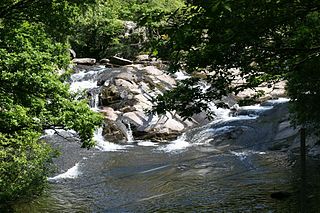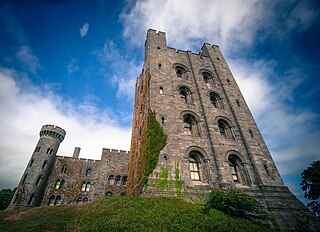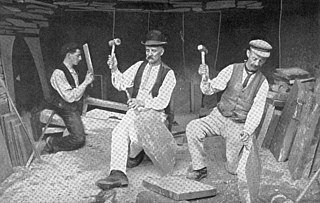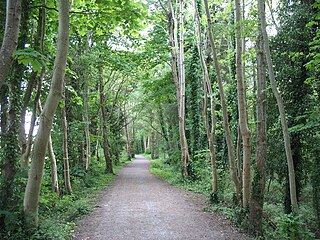
Caernarfon is a royal town, community, and port in Gwynedd, Wales, with a population of 9,852. It lies along the A487 road, on the eastern shore of the Menai Strait, opposite the Isle of Anglesey. The city of Bangor is 8.6 miles (13.8 km) to the north-east, while Snowdonia fringes Caernarfon to the east and south-east. Carnarvon and Caernarvon are Anglicised spellings that were superseded in 1926 and 1974 respectively.
Penryn is a Cornish word meaning 'headland' that may refer to:

Bethesda is a town and community on the River Ogwen and the A5 road on the edge of Snowdonia, in Gwynedd, north-west Wales. It is the 5th largest Community in Gwynedd.

The Afon Ogwen is a river in north-west Wales draining from some of the greatest peaks in Snowdonia before discharging to the sea on the eastern side of Bangor, Gwynedd.

The Penrhyn Quarry Railway was a narrow gauge railway in Caernarfonshire, Wales. It served the Penrhyn quarry near Bethesda, taking their slate produce to Port Penrhyn, near Bangor. The railway was around six miles (9.7 km) long and used a gauge of 1 ft 10+3⁄4 in.

Rachub is a village of about 900 people in Dyffryn Ogwen, Gwynedd, Wales, about three-quarters of an mile (1.2 km) north of the town of Bethesda. It forms part of the Llanllechid community, which had a population of 889 in the 2011 census.

Dyffryn Ogwen, or Ogwen Valley, is a valley mostly located in the Welsh county of Gwynedd. The upper section of the valley, east of Llyn Ogwen, lies in the county of Conwy.

The Penrhyn quarry is a slate quarry located near Bethesda, North Wales. At the end of the nineteenth century it was the world's largest slate quarry; the main pit is nearly 1 mile (1.6 km) long and 1,200 feet deep, and it was worked by nearly 3,000 quarrymen. It has since been superseded in size by slate quarries in China, Spain and the USA. Penrhyn is still Britain's largest slate quarry but its workforce is now nearer 200.

Penrhyn Castle is a country house in Llandygai, Bangor, Gwynedd, North Wales, in the form of a Norman castle. It was originally a medieval fortified manor house, founded by Ednyfed Fychan. In 1438, Ioan ap Gruffudd was granted a licence to crenellate and he founded the stone castle and added a tower house. Samuel Wyatt reconstructed the property in the 1780s.

The existence of a slate industry in Wales is attested since the Roman period, when slate was used to roof the fort at Segontium, now Caernarfon. The slate industry grew slowly until the early 18th century, then expanded rapidly until the late 19th century, at which time the most important slate producing areas were in northwest Wales, including the Penrhyn Quarry near Bethesda, the Dinorwic Quarry near Llanberis, the Nantlle Valley quarries, and Blaenau Ffestiniog, where the slate was mined rather than quarried. Penrhyn and Dinorwig were the two largest slate quarries in the world, and the Oakeley mine at Blaenau Ffestiniog was the largest slate mine in the world. Slate is mainly used for roofing, but is also produced as thicker slab for a variety of uses including flooring, worktops and headstones.

The Penrhyn Castle Railway Museum is a museum of industrial railway equipment, located at Penrhyn Castle near Bangor in Wales.

Y Fron, also known locally as Cesarea, after the chapel, is a country village on the south-west side of Moel Tryfan, overlooking the Nantlle Valley, in North Wales, near Rhosgadfan and Carmel, on the tail of Mynydd Mawr, with epic views of Trum Y Ddysgl and Craig Cwm Silyn. It is in the community of Llandwrog.
Moelyci Environmental Centre is a community project based near the village of Tregarth, in the county of Gwynedd in north-west Wales.
Ysgol Dyffryn Ogwen is a bilingual school in Bethesda in the Ogwen Valley in Gwynedd, Wales, with 374 pupils. Some of the buildings date from 1895 when a County School was established here, but the present comprehensive school dates from 1951. An extension to the school was opened by Professor Sir Idris Foster. The motto of the school is "Bydded goleuni"

Llandygai is a small village and community on the A5 road between Bangor and Tal-y-Bont in Gwynedd, Wales. It affords a view of the nearby Carneddau mountain range. The population of the community taken at the 2011 Census was 2,487. Llandygai community includes nearby Tregarth and Mynydd Llandygai and also the pass of Nant Ffrancon.

The Afon Cegin is a small river draining parts of North Wales and discharging to the Menai Strait at Porth Penrhyn. Its name means Kitchen River in English.
The Bethesda branch line was a 4+1⁄4-mile (6.8 km) railway branch line between Bangor and Bethesda in Gwynedd, North Wales. Its primary purpose was to bring quarried slate down to the main line for onward transport.

Lôn Las Ogwen is a 17.7 km (11.0 mi) cycle route in the National Cycle Network which runs south from the NCN 5 at Porth Penrhyn on the north coast of Wales to Llyn Ogwen in Snowdonia. Lôn Las Ogwen is Welsh for "Green Lane".

The Pantdreiniog quarry was a slate quarry within the town of Bethesda in North Wales. It was worked between about 1825 and 1923. It played a significant part in the Penrhyn Great Strike, Britain's longest industrial dispute.
![Slate industry in the Nantlle Valley Slate quarries in the [[Nantlle Valley]]](https://upload.wikimedia.org/wikipedia/commons/thumb/c/ce/Dorothea_pumping_engine_and_Penyrorsedd_Quarries_-_geograph.org.uk_-_300611.jpg/320px-Dorothea_pumping_engine_and_Penyrorsedd_Quarries_-_geograph.org.uk_-_300611.jpg)
The Slate Industry in the Nantlle Valley was the major industry of the area. The Nantlle Valley is the site of oldest slate quarry in Wales at Cilgwyn, and during the nineteenth and twentieth centuries it was a major centre of the Slate industry in Wales. The quarries of the area are being considered as a World Heritage site.

















![Slate industry in the Nantlle Valley Slate quarries in the [[Nantlle Valley]]](https://upload.wikimedia.org/wikipedia/commons/thumb/c/ce/Dorothea_pumping_engine_and_Penyrorsedd_Quarries_-_geograph.org.uk_-_300611.jpg/320px-Dorothea_pumping_engine_and_Penyrorsedd_Quarries_-_geograph.org.uk_-_300611.jpg)
